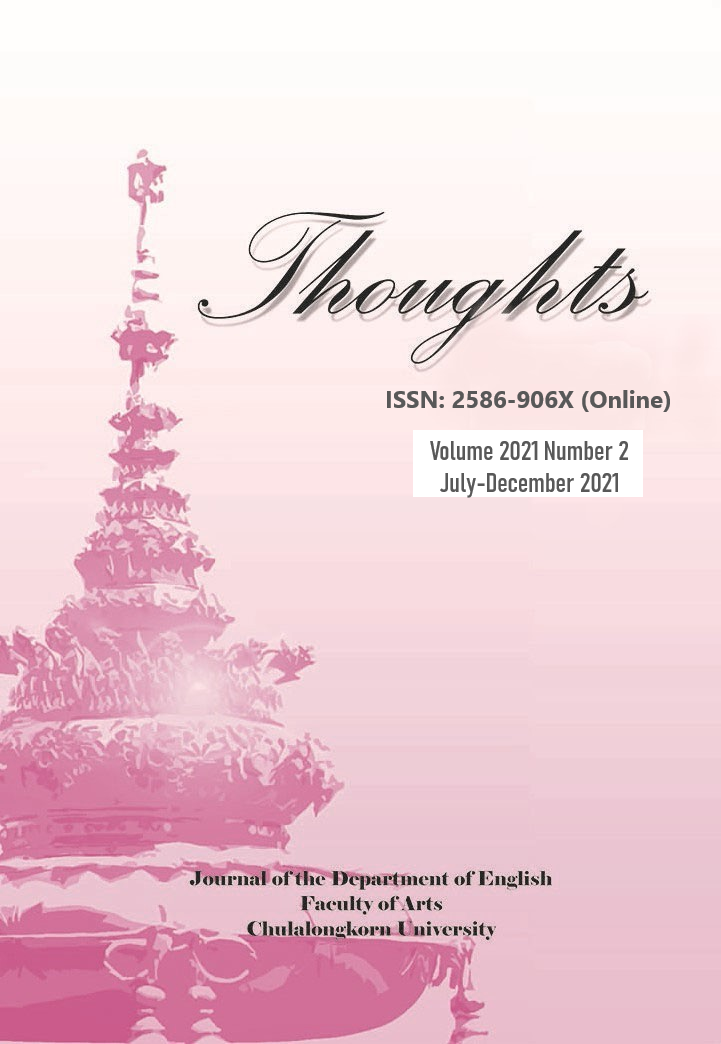The London in Pride and Prejudice and Zombies (2009) and its 2016 Filmic Adaption
DOI:
https://doi.org/10.58837/CHULA.THTS.2021.2.2Keywords:
Pride and Prejudice and Zombies, zombie, London, apocalypse, mashupAbstract
This paper aims to read the zombies in Pride and Prejudice and Zombies (2009) and its 2016 filmic adaption by Burr Steers as embodiments of the lower classes and foreign invaders in Austen’s novels. Zombies, as popular monsters, are linked with social disorder, filth and disease, all of which the upper social strata in Jane Austen’s time believed to be associated with the lower classes. By the addition of a zombie outbreak to Austen’s Pride and Prejudice, Grahame-Smith manifests Austen’s or the late-eighteenth-century gentry’s and the upper classes’ anxiety about the lower social classes and the masses in London with their tendency to stage riots and spread disease. In the filmic adaption, the zombies embody foreign invaders attempting to destroy London which stands for the nation. The collapse of London suggests that the film follows the popular cinematic representation of the city in apocalyptic zombie films. To achieve its aim, this paper employs a socio-historical approach by analyzing Austen’s works against the socio-historical context of the late eighteenth and early nineteenth centuries with regard to the lower social orders and foreign invasion, revealing the threats they pose and illustrating how these threats are captured by zombies.
References
References
Austen, J. (1994). Northanger Abbey. The Project Gutenberg. https://www.gutenberg.org/files/121/121-h/121-h.htm
Austen, J. (1998). Pride and Prejudice. The Project Gutenberg. https://www.gutenberg.org/files/ 1342/1342-h/1342-h.htm
Bishop, K. W. (2015). How zombies conquered popular culture: The multifarious walking dead in the 21st Century. McFarland and Company.
CBC Arts. (2009, February 9). Austen’s Pride and Prejudice set for zombie mash-up. CBC News.
https://www.cbc.ca/news/entertainment/austen-s-pride-and-prejudice-set-for-zombie-mash-up-1.781159
Chretien, E. (2011). Gentility and the canon under siege: Pride and Prejudice and Zombies, violence, and contemporary adaptations of Jane Austen [Master’s thesis, University of Nebraska, Nebraska]. UNL's Institutional Repository. https://digitalcommons.unl.edu/cgi/viewcontent.cgi? article=1059&context=englishdiss
Cicchini, P. (2014, April 16). How to write a mashup novel. Writer’s Digest. https://www.writersdigest.com/write-better-fiction/how-to-write-a-mashup-novelcom/essays/literary-mashup/
Dercksen, D. (2016, February 25). Fusing classic Jane Austen and a Zombie apocalypse. The Writing Studio. https://writingstudio.co.za/fusing-classic-jane-austen-and-a-zombie-apocalypse/
Grahame-Smith, S., & Austen, J. (2009). Pride and Prejudice and Zombies. Philadelphia: Quirk Books.
Halford, M. (2009, April 4). Jane Austen does the monster mash. The New Yorker. https://www.newyorker.com/books/page-turner/jane-austen-does-the-monster-mash
Harvey, G. (1665). A discourse of the plague. Printed for Nath. Brooke, at the Angel in Cornhill, near the Royal Exchange. https://quod.lib.umich.edu/e/eebo/A43015.0001.001/1:2?rgn=div1;view=fulltext
Jacobsen, C. B. (2009). Pride and Prejudice and Zombies: The classic regency romance—now with ultraviolent zombie mayhem! by Jane Austen and Seth Grahame-Smith [Book review]. Transformative Works and Cultures, 3. https://doi.org/10.3983/twc.2009.0181
Ladd, J. (2010). Dawn of the literary mash-up. Escape Into Life. https://www.escapeintolife.
Lanzendörfer, T. (2018). Books of the dead: Reading the zombie in contemporary literature. University Press of Mississippi.
McDonald, J. C. (1951). The history of quarantine in Britain during the 19th Century. Bulletin of the History of Medicine, 25(1), 22-44.
McMaster, J. (1997). Class. In E. Copeland & J. McMaster (Eds.), The Cambridge companion to Jane Austen class (pp. 115-130). Cambridge University Press.
Mead, R. (1720). A short discourse concerning pestilential contagion, and the methods to be used to prevent It. Printed for Sam. Buckley in Amen-Corner, and Ralph Smith at the Royal-Exchange.
Merritt, S. (2009, December 6). Pride and Prejudice and Zombies by Jane Austen and Seth Grahame-Smith. The Guardian. https://www.theguardian.com/books/2009/dec/06/pride-prejudice-zombies-grahame-smith
Miller, C. (2016). Pride+Prejudice+Zombies. International Journal of Jungian Studies, 8(2), 136-140. http://dx.doi.org/10.1080/19409052.2016. 1160615
Mullan, J. (2013). What matters in Jane Austen?: Twenty crucial puzzles solved. Bloomsbury Press.
Mullett, C. F. (1936). The English plague scare of 1720-23. Osiris, 2, 484-516.
Nelson, C. (2013). Jane Austen … now with ultraviolent zombie mayhem. Adaptation, 6(3), 338–354.
Peakman, J. (2016). Amatory pleasures: Explorations in eighteenth-century sexual culture. Bloomsbury Press.
Riter, A. V. (2017). The evolution of mashup literature: Identifying the genre through Jane Austen’s novels [Master’s thesis, De Montfort University, Leicester]. DORA. https://dora.dmu.ac.uk/bitstream/handle/2086/14209/Riter%20-%20MPhil%20Edited.pdf?sequence=1
Russell, G. (2012). The army, the navy, and the Napoleonic wars. In C. L. Johnson & C. Tuite (Eds.), A companion to Jane Austen (pp. 261-271). Wiley-Blackwell.
Steers, B. (Director). (2016). Pride + Prejudice + Zombies [Film]. Cross Creek Pictures; Sierra Pictures; MadRiver Pictures; QC Entertainment; Allison Shearmur Productions; Handsomecharlie Films; Head Gear Films.
Tampa, M., Sarbu, I., Matei, C., Benea V., & Georgescu, S. R. (2014). Brief history of syphilis. Journal of Medicine and Life, 7(1). https://www.ncbi.nlm.nih.gov/pmc/articles/
The National Achieve. (n.d.). The Gordon Riots. https://www.nationalarchives.gov.uk/pathways/ blackhistory/rights/gordon.htm
Venables, T. (2015). Zombies, a lost literary heritage and the return of the repressed. In L. Hubner, M. Leaning, & P. Manning (Eds.), The zombie renaissance in popular culture (pp. 208-233). Palgrave Macmillan.
Whittaker, R. (2016, February 4). Adapting Pride and Prejudice and Zombies. The Austin Chronicle. https://www.austinchronicle.com/daily/ screens/2016-02-04/adapting-pride-and-prejudice-and-zombies/
Williams, A. S. (1987). The rich man and the diseased poor in early Victorian literature. Palgrave Macmillan.
Winick, S. (2014, July 24). Ring around the Rosie: Metafolklore, rhyme and reason. Library of Congress. https://blogs.loc.gov/folklife/2014/07/ring-around-the-rosie-metafolklore-rhyme-and-reason/
Downloads
Published
Issue
Section
License
Copyright (c) 2021 Thoughts

This work is licensed under a Creative Commons Attribution-NonCommercial-NoDerivatives 4.0 International License.
Copyright by the Faculty of Arts, Chulalongkorn University.
Photocopying is allowed for internal, non-commercial use only. Photocopying for other uses or for purposes other than indicated must be permitted in writing from the Faculty of Arts, Chulalongkorn University.
All views or conclusion are those of the authors of the articles and not necessarily those of the publisher or the editorial staff.


